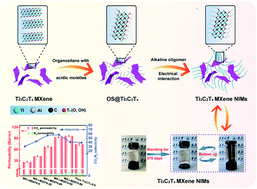Transforming Ti3C2Tx MXenes into nanoscale ionic materials via an electronic interaction strategy†
Abstract
MXenes, an emerging class of two-dimensional (2D) materials, have driven a tremendous amount of research due to their fascinating properties including excellent metallic conductivities, favorable mechanical stability and easily tailorable surface chemistry. However, the daunting drawbacks of MXene flake restacking and oxidation instability hinder their further applications. To this end, we proposed a universal approach to transform Ti3C2Tx MXenes into nanoscale ionic materials (NIMs) using an electronic interaction strategy, where the Ti3C2Tx MXenes were firstly modified using an organosilane (OS) with acidic moieties, before electrostatic grafting of an alkaline oligomer to form the resultant stable electron-balanced MXene NIMs. The as-prepared Ti3C2Tx MXene NIMs presented rather stable antioxidant ability even after standing for 570 days. Moreover, MXene NIMs exhibit macroscopic flow behaviors at room temperature, which greatly improve processability and show extensive potential in addressing the daunting restacking issue when blending Ti3C2Tx MXene flakes with other polymer matrixes. Furthermore, the generality of this strategy was demonstrated by using various classes of alkaline oligomer species. As a proof of concept, Ti3C2Tx MXene NIMs (e.g., MX-I-M2070) were incorporated into the Pebax-1657 matrix to prepare mixed matrix membranes (MMMs), where the CO2 selective separation was investigated using experimental and molecular simulation (MS) methods. More notably, the rich library of alkaline oligomer species provides more convenience for further structural optimization, thus opening up plentiful opportunities for advancing the development of MXene NIMs towards other task-specific applications, such as catalysis and photothermal conversion.



 Please wait while we load your content...
Please wait while we load your content...